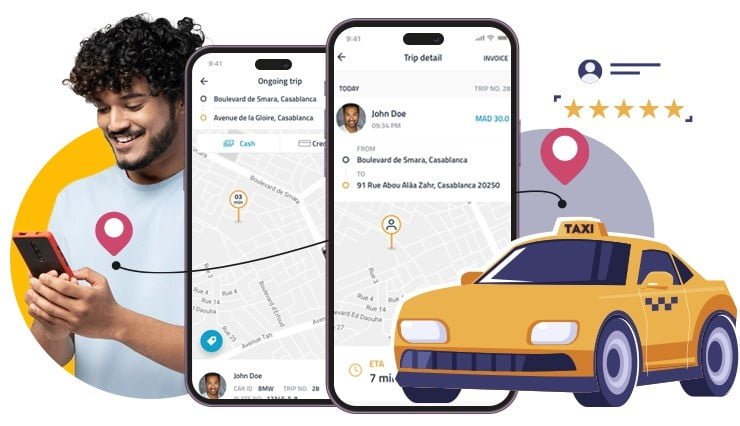In today’s fast-paced world, ride-hailing apps have revolutionized how people commute. Uber and Ola Clone have changed the transportation sector by offering riders quick and economical transportation options. If their success inspires you and you want to create your own taxi app, you have reached the perfect spot. This definitive tutorial will coach you through the key phases and concerns of developing a taxi app similar to Uber and Ola.
Understanding The Market
Analyzing the market and trends is critical before the Uber-like taxi app development process begins. Conduct extensive market research to determine your target region’s demand, competition, and opportunities. Analyze user preferences, pricing patterns, and current pain areas to make your app stand out in a crowded market.
Identifying Key Features
To create a successful taxi app, you must identify the main features that will improve the user experience and set your app apart from its competitors. Some key features include:
- User Registration and Authentication
- Ride reservations and scheduling
- Real-time ride tracking and geolocation.
- In-app payments and fare estimates
- Reviews and ratings for both passengers and drivers
- Get push alerts for updates and promotions.
Design and user experience.
A visually appealing and user-friendly design is essential for attracting and maintaining visitors. Invest in developing an intuitive user interface (UI) and a smooth user experience (UX). Color schemes, fonts, and iconography should all be carefully considered to ensure that your app reflects your corporate identity and gives users a pleasurable experience.
Technology Stack
Choosing the correct technology stack is critical to the performance and scalability of your taxi app. Consider developing cross-platform apps with popular frameworks and programming languages like React Native or Flutter. Choose a dependable and scalable backend architecture to manage the app’s data and server-side processes.
Backend Development
Backend development for your taxi app includes server-side functionality, APIs, and database management. Concentrate on scalability, security, and real-time data processing. Optimize your backend infrastructure to handle large amounts of concurrent queries while maintaining data privacy.
Front End Development
Front-end development for your app includes designing the user interface and implementing the program’s functionalities. Use responsive design concepts to ensure that your app works on a variety of devices and screen sizes. Use frameworks such as React or Angular for effective front-end development.
Payment Integration
Integrating secure and convenient payment alternatives is critical for providing a consistent user experience. Partner with reputable payment gateways to enable cashless transactions in your app. Implement strong security measures to protect users’ financial data.
Real-time tracking and geolocation.
Real-time tracking and geolocation are crucial aspects of a taxi app. Integrate dependable mapping and geolocation technologies to enable precise position tracking for drivers and passengers. Use GPS technology to improve route planning and deliver precise arrival forecasts.
Driver and Passenger Profiles
Creating complete driver and passenger profiles fosters trust and enhances the overall experience. Allow users to examine driver ratings, reviews, and other pertinent information before scheduling a ride.
Reviews and Ratings
Adding a review and rating system to your taxi app allows passengers to submit input on their journey experience. Encourage users to evaluate drivers and offer feedback to help maintain service quality and accountability. Use this feedback to constantly enhance your app and address any issues highlighted by users.
Pricing and Revenue Models
Creating a fair and clear pricing model is critical to attracting customers. Consider various price models to balance supply and demand, such as dynamic or surge pricing during peak hours. Consider other revenue streams, such as driver commissions or promotional collaborations with local businesses.
Testing and Quality Assurance
Before launching your taxi app, be sure it has been thoroughly tested and quality assured. Conduct thorough testing to ensure seamless functionality, eradicate defects, and optimize performance. Test the app on a variety of devices and operating systems to ensure that all users have a consistent experience.
Launching Your Taxi App.
Once your software has been completely tested and is ready for launch, it is time to plan for distribution. Optimize your app store listings with relevant keywords and appealing descriptions to increase visibility. Create a complete marketing strategy to raise awareness and attract new customers.
Marketing and Promotion
Your taxi app’s success depends on effective marketing and promotion. Use digital marketing tactics like search engine optimization (SEO), social media marketing, and customized advertising to reach your target audience. Provide incentives and referral schemes to boost user acquisition and retention.
Conclusion
Building taxi apps like Uber Clone and Ola involves rigorous planning, diligent programming, and a commitment to providing a great customer experience. Understanding the market, identifying critical features, and utilizing the correct technological stack can help you design a successful taxi app that fits the demands of both drivers and riders. Remember to always listen to user input, adapt to changing market dynamics, and keep up with the latest trends to keep your app competitive in the marketplace.







Leave a Reply